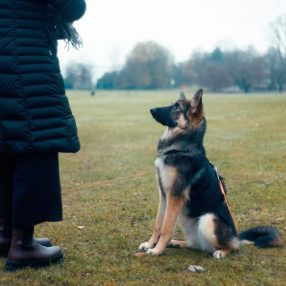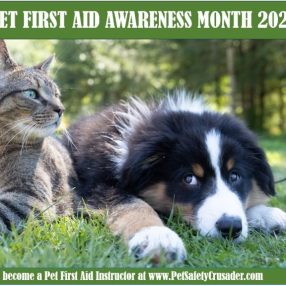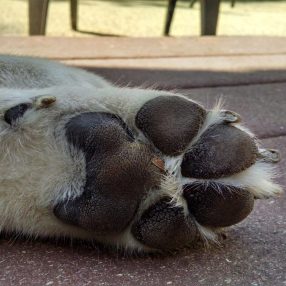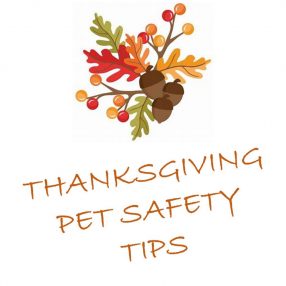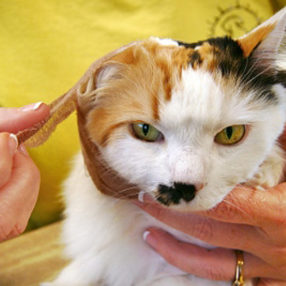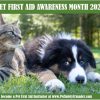Follow these ten steps and you’ll start on a path to helping your furry kids live a longer, happier, healthier life.
With no real Pet Parenting 101 Class to be found, there are still things to be learned that can help you better handle the furry kids in your care. Many are common sense and others not, but by taking to heart the steps below, you’re sure to go to the head of the class in your pet’s eyes.
- Establish a good relationship with your veterinarian and take care in choosing him or her in the first place. Make sure your pets get annual check-ups, vaccinations and special tests for seniors. These exams can bring to light the potential for later problems. Knowledge is power, so become aware and prevent bad occurrences from rearing their ugly heads. Help your Vet help your pet by brushing your cat or dog’s teeth regularly with toothpaste designed for pets (never human toothpaste which contains detergents) and check for “bubble-gum” pink gums, white teeth and no odor which are all signs of good health. Also have their teeth cleaned professionally twice a year. If you are concerned about anesthesia, there are great anesthesia-free clinics – no excuses!
- Learn the shortest route to your nearest 24-hour Emergency Center. Posting the address on your refrigerator isn’t good enough. Drive there so that when you have an emergency, you’ll know the shortest route from your home without having to get directions. Additionally, if your dog has a favorite hiking spot or park, learn where the nearest emergency care center is to that location.
- Observe your pet and do a head to tail check weekly. Feel for lumps and bumps (catching a tumor early can save a life), check the condition of his coat and skin, and always look for fleas, ticks and foxtails when your animals come in from the yard or a hike. Really get to know your pet’s habits. Be aware of how many times a day you fill water bowls and let pets outside. If suddenly your pet is asking you to perform these tasks more or less frequently than usual, they may need a check-up. Notice how your dog or cat sits and stands. Is he suddenly leaning on one hip or seeming to labor getting up off the ground? By knowing what is normal you can quickly identify something abnormal.
- Obedience Train and Socialize your dog. A well-behaved canine stays out of trouble and is a welcome member of the family. He is less likely to escape into traffic or eat something poisonous out of the trash. A well-socialized canine is friendly around other animals and people, is a welcome visitor to parks and pet-friendly locales and is an agreeable member of the family. He is less apt to get into a fight with other animals out of fear or bad manners.
- Always keep your dog on a leash or in a fenced yard so that you can keep them safe from traffic (the #1 most preventable injury to dogs and man), other animals, pesticides that might be on your neighbor’s lawn, poisons in garbage cans and more. Check around your home to keep dangerous items at bay. And when your dog is in that fenced yard, please always make sure he has access to shade and fresh water.
- Exercise your pet. Keep your pet’s body and mind stimulated for a long, happy and healthy life. Boredom is the playground for bad habits and destructive behaviors. Digging can lead to Houdini-like escapes landing your loving cat or dog in a shelter or hit by a car while injuries can be caused from items torn, ingested or broken. Physical activity and fresh air does a canine and a feline body good, but so does time spent with you!
- Feed high quality age appropriate food to your pet everyday. Read the labels and know what you are giving him. Supplement the food with antioxidants to protect your kitty or pooch from the inside out. Free radicals (unstable oxygen molecules) strike every cell in his body 10,000 times per day until they eventually break down and weaken the cells causing allergies, skin and coat problems, tumors, cancers, heart & vessel disease, arthritis and more. You may not notice their ill effects for years, until the damage has already been done.
- ID your pet. In addition to tags, it is important to get your pet micro-chipped so that he can be quickly identified in the event tags are lost.
- Spay or Neuter your Dog or Cat. Unaltered pets have a tendency to roam in search of a mate. According to the SPCA, the majority of animals killed on streets and highways are un-neutered males. Additionally, unaltered dogs and cats display a higher level of aggression and their risks for certain types of cancer (mammary and prostate) are increased. The United States is faced with an overwhelming homeless pet problem. Become part of the solution, not part of the problem.
- Sign up for a Pet First Aid & CPR Class to prepare you to handle the unexpected.
Your dog or cat will thank you and you will thank yourself for helping your furry kid live a longer, happier, healthier life!
Note: The articles on this page are copyrighted. Please do not reprint or use portions for any purpose without written permission from the author. Request permission for usage by sending an email explaining how you’d like to use the materials and what parts specifically. Thank you in advance!

